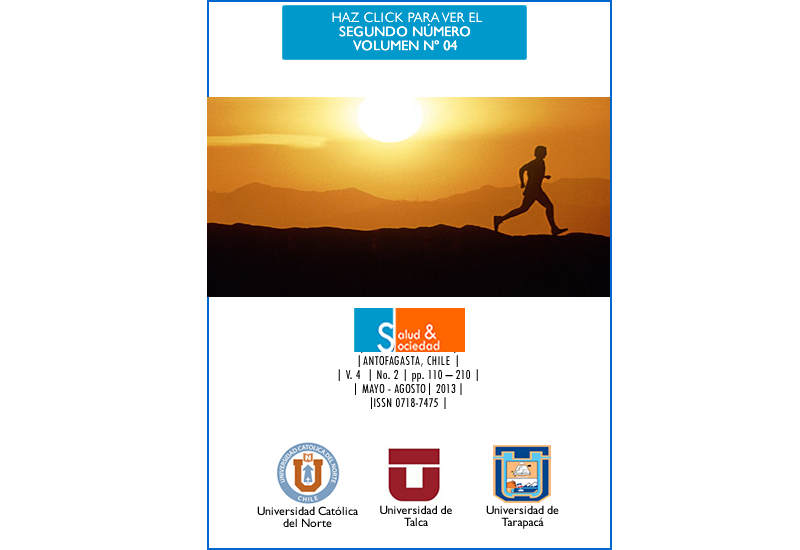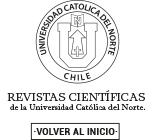Prevalencia y sintomatología del estrés post traumático en personas que experimentan un terremoto y un tsunami.
DOI:
https://doi.org/10.22199/S07187475.2013.0002.00003Palavras-chave:
Trastorno por Estrés Postraumático, Prevalencia, Terremotos, Tsunamis, Post-Traumatic Stress, Prevalence, Earthquakes,Resumo
Introducción : Se sabe que la prevalencia del estrés post-traumático (TEPT) es significativamente mayor después de terremotos y tsunamis como el del 27 de febrero de 2010 (27-F). Objetivos: (1) Determinar las proporciones de personas que podrían presentar TEPT y cada uno de sus tipos de síntomas, (2) relacionar las proporciones con grupos de variables que pueden favorecer su aparición, y (3) establecer un perfil de síntomas según cada grupo de variables. Método: Mediante las escalas Short Posttraumatic Stress Disorder Rating Interview (SPRINT-E) y la Davidson Trauma Scale (DTS), medimos la cantidad de síntomas intensos de TEPT en dos muestras: habitantes del litoral (n=194) y del interior (n=94) de la zona central de Chile. Resultados: La prevalencia del TEPT alcanza el 22%, siendo 19 puntos mayor en personas que habitan la zona costera (28%) y 11 puntos mayor entre quienes han sufrido graves daños en su vivienda. Discusión: Quienes sufren graves daños o viven en una ciudad costera impactada por terremoto y tsunami tienden a tener más síntomas de re-experimentación e híper-activación, se muestran más tristes, tienen menos cuidado por su salud, se sienten incómodos e interferidos en sus actividades cotidianas y se les hace difícil resolver problemas que antes solucionaban sin ayuda.
Introduction : Previous research indicates an increased prevalence of post-traumatic stress disorder (PTSD) after earthquakes and tsunamis as the February 27, 2010 (F-27). Objectives: (1) To determine the proportions of people who could present PTSD and each of its types of symptoms, (2) relate the proportions with groups of variables that may favor its appearance, and (3) establish a symptom profile as each group of variables. Method : Using the Short Posttraumatic Stress Disorder Rating Interview (SPRINT-E) and the Davidson Trauma Scale (DTS), we measured the PTSD intense symptoms in two samples: inhabitants of coast (n=194) and interior (n=94). Results: The PTSD prevalence was 22%, 19 points higher in people that live in coastal area (28%) and 11 points higher among people that suffered severe damage in their home. Discussion : Those who suffer serious house damages or live in a coastal town hit by earthquake and tsunami tend to have more symptoms of re-experiencing, hyper-activation, are sadder, have less care for their health, feel uncomfortable and interfered in their daily activities and they find difficult to solve problems that previously solved without help.
Downloads
Referências
Bland, S., Valoroso, L., Stranges, S., Strazzullo, P., Farinaro, E., & Trevisan, M. (2005). Long-term follow-up of psychological distress following earthquake experiences among working Italian males: a cross-sectional analysis. Journal of Nervous and Mental Disease, 193, 420–423.
Bobes, J., García-Calvo, C., Prieto, R., García-García, M., & RicoVillademoros, F. (2006). Psychometric properties of the Spanish version of the screening scale for DSM-IV Generalized Anxiety Disorder of Carroll and Davidson. Actas Españolas de Psiquiatría, 34(2), 83–93. Retrieved from http://www.ncbi.nlm.nih.gov/pubmed/16552636
Bödvarsdóttir, I. & Elklit, A. (2004). Psychological reactions in Icelandic earthquake survivors. Scandinavian Journal of Psychology, 45, 3-13.
Cairo, J. B., Dutta, S., & Nawaz, H. (2010). The prevalence of posttraumatic stress disorder among adult earthquake survivors in Perú. Disaster Medicine and Public Health Preparedness, 4, 39–46.
Campbell, D., Felker, B., Liu, C., Yano, E., Kirchner, J., Chan, D., Rubenstein, L. & Chaney, E. (2007). Prevalence of depression-PTSD comorbilidity: Implications for clinical practice guidelines and primary care-based interventions. Journal of General Internal Medicine, 22, 711-718.
Canetti, D., Galea, S., Hall, B., Johnson, R., Palmieri, P. & Hobfoll, S. (2010). Exposure to prolongued socio-political conflict and the risk of PTSD and depression among Palestians. Psychiatry, 73(3), 219-231.
Cougle, J., Resnick, H., & Kilpatrick, D. (2009). PTSD, depression, and their comorbidity in relation to suicidality: cross-sectional and prospective analyses of a national probability sample of women. Depression and Anxiety, 26, 1151–1157.
Davidson, J. R. T., Book, S. W., Colket, J. T., Tupler, L. A., Roth, S., David, D., Hertzberg, M., et al. (1997). Assessment of a new self-rating scale for posttraumatic stress disorder. Psychological Medicine, 27, 153–160.
Davidson, J., Hughes, D., Blazer, D. & George L. (1991). Posttraumatic stress disorder in the community: an epidemiological study. Psychological Medicine, 21, 713–721.
Dewaraja, R., & Kawamura, N. (2006). Trauma intensity and posttraumatic stress: Implications of the tsunami experience in Sri Lanka for the management of future disasters. International Congress Series, 1287, 69–73.
Eksy, A., Braun, K., Ertem-Vehid, H., Peykerli, G., Saydam, R., Toparlak, D. & Alyanak, B. (2007). Risk factors for the development of PTSD and depression among child and adolescent victims following a 7.4 magnitude earthquake. International Journal of Psychiatry in Clinical Practice, 11(3), 190-199.
Encinas, D., & Valdés, G. (2012). Adaptación de un procedimiento psicoterapéutico para el estrés postdesastre aplicado después del terremoto y tsunami del 27 de Febrero de 2010. Memoria de Grado, Universidad de Talca.
Friedman, M. J., Resick, P. A, Bryant, R. A, & Brewin, C. R. (2011). Considering PTSD for DSM-5. Depression and Anxiety, 28(9), 750–69. doi:10.1002/da.20767
Galea, S., Nandi, A., & Vlahov, D. (2005). The epidemiology of Post-Traumatic Stress Disorder after disasters. Public Health, 27, 78–91. doi:10.1093/epirev/mxi003
Goenjian, A. K., Steinberg, A. M., Najarian, L. M., Fairbanks, L. A., Tashjian, M., & Pynoos, R. S. (2000). Prospective study of posttraumatic stress, anxiety, and depressive reactions after earthquake and political violence. American Journal of Psychiatry, 157(6), 911–916.
Goenjian, A., Noble, E., Walling, D., Goenjian, H., Karayan, I., Ritchie, T. & Bailey, J. (2008). Heritabilities of symptoms of posttraumatic stress disorder, anxiety, and depression in earthquake exposed Armenian families. Psychiatric Genetics, 18, 261-266.
Hamblen, J. L., Norris, F. H., Pietruszkiewicz, S., Gibson, L. E., Naturale, A., & Louis, C. (2009). Cognitive behavioral therapy for postdisaster distress?: A community based treatment program for survivors of hurricane Katrina. Stress: The International Journal on the Biology of Stress, 206–214. doi:10.1007/s10488-009-0213-3
Lai, T. J., Chang, C. M., Connor, K. M., Lee, L. C., & Davidson, J. R. (2004). Fulland partial PTSD among earthquake survivors in rural Taiwan. Journal of Psychiatric Research, 38, 313–322.
Larrañaga, O., & Herrera, R. (2010). Encuesta Post Terremoto?: Principales resultados (p. 33). Santiago de Chile.
Leiva-Bianchi, M. C., & Gallardo, I. (2013). Validation of the short posttraumatic stress disorder rating interview (SPRINT-E ) in a sample of people affected by F-27 Chilean earthquake and tsunami. Anales de Psicología, 29(2), 328–334.
Leiva-Bianchi, M., & Quintana, G. R. (2010). Factores ambientales y psicosociales vinculados a síntomas de ataque de pánico después del terremoto y tsunami del 27 de Febrero de 2010 en la zona central de Chile . Terapia Psicológica, 28(747), 161–168.
Leiva-Bianchi, M. (2011). Relevancia y prevalencia del estrés post-traumático post-terremoto como problema de salud pública en Constitución, Chile. Revista de Salud Pública, 13(4), 551–559.
McMillen, J. C., North, C. S., & Smith, E. M. (2000). What parts of PTSD are normal: Intrusion, avoidance, or arousal? Data from the Northridge, California earthquake. Journal of traumatic stress, 13(1), 57–75. doi:10.1023/A:1007768830246
Miller, M. W., Wolf, E. J., Kilpatrick, D., Resnick, H., Marx, B. P., Holowka, D. W., Keane, T. M., et al. (2012). The Prevalence and latent structure of proposed DSM-V posttraumatic stress disorder symptoms in U.S. National and Veteran Samples. Psychological Trauma: Theory, Research, Practice, and Policy. doi:10.1037/a0029730
Norris, F. H., & Elrod, C. L. (2006). Psychosocial consequences of disaster. In Frann Norris, S. Galea, M. J. Friedman, & P. Watson (Eds.), Methods for Disaster Mental Health Research (pp. 20–42). New York: The Guilford Press.
Norris, F., Friedman, M. & Watson, P. (2002). 60,000 disaster victims speak: Part II. Summary and implications of the disaster mental health research. Psychiatry, 65(3), 240-260.
Norris, F., Hamblen, J., Brown, L., & Schinka, J. (2008). Validation of the Short Posttraumatic Stress Disorder Rating Interview (expanded version, Sprint-E) as a measure of postdisaster distress and treatment need. American Journal of Disaster Medicine, 3(4), 201–212.
Norris, F., Weisshaar, D., Conrad, M., Díaz, E., Murphy, A., & Ibañez, G. (2001). A qualitative analysis of posttraumatic stress among Mexican victims of disaster. Journal of Traumatic Stress, (14)4, 741-756.
PAHO-Panamerican Health Organization. (2010). El terremoto y el tsunami del 27 de febrero en Chile: Crónicas y lecciones aprendidas en el sector salud [The earthquake and tsunami in Chile February 27: Chronicles and lessons learned in the health sector] (p. 111). Santiago de Chile: PAHO-Panamerican Health Organization.
Pardo, A. (2002). Análisis de datos categóricos. Madrid: UNED Ediciones.
Pérez, C., Vicente, B., Zlotnick, C., Kohn, R., Johnson, J., Valdivia, S., & P., R. (2009). Estudio epidemiológico de sucesos traumáticos, trastorno de estrés post-traumático y otros trastornos psiquiátricos en una muestra representativa de Chile. Salud Mental, 32, 145–153.
Rodriguez, J., Zaccarelli, M., & Perez, R. (2006). Guía práctica de salud mental en situaciones de desastres. Washington DC: PAHO-Panamerican Health Organization.
Roussos, A., Goenjian, A., Steinberg, A., Sotiropoulou, C., Kakaki, M., & Kabakos, C. (2005). Posttraumatic stress and depressive reactions among children and adolescents after the 1999 earthquake in Ano Liosia, Greece. American Journal of Psychiatry, 162, 530–537.
Sharan, P., Chaudhary, G., Kavathekar, S., & Saxena, S. (1996). Preliminary report of psychiatric disorders in survivors of a severe earthquake. American Journal of Psychiatry, 153, 556–558.
Shinfuku, N. (2002). Disaster mental health: Lessons learned from the Hanshin Awaji earthquake. World Psychiatry, 1, 158–159.
Solvason, H. B., Ernst, H., & Roth, W. (2003). Predictors of response in anxiety disorders. Psychiatry: Interpersonal and Biological Processes, 26, 411–433. doi:10.1016/S0193-953X(03)00027-3
USGS-United States Geological Survey. (2013). Tsunami and earthquake research. Retrieved January 15, 1BC, from http://walrus.wr.usgs.gov/tsunami/
Wu, H.-C., Chou, P., Chou, F. H.-C., Su, C.- Y., Tsai, K.-Y., Ou-Yang, W.-C., Su, T. T.-P., et al. (2006). Survey of quality of life and related risk factors for a Taiwanese village population 3 years post-earthquake. Australian and New Zealand Journal of Psychiatry, 40(4), 355–361. doi:10.1111/j.1440-1614.2006.01802.x.
Downloads
Publicado
Edição
Seção
Licença
Los autores continúan como propietarios de sus trabajos, y pueden volver a publicar sus artículos en otro medio sin tener que solicitar autorización, siempre y cuando indiquen que el trabajo fue publicado originariamente en Revista Salud & Sociedad (ISSNe:0718-7475).



_(1).png)





